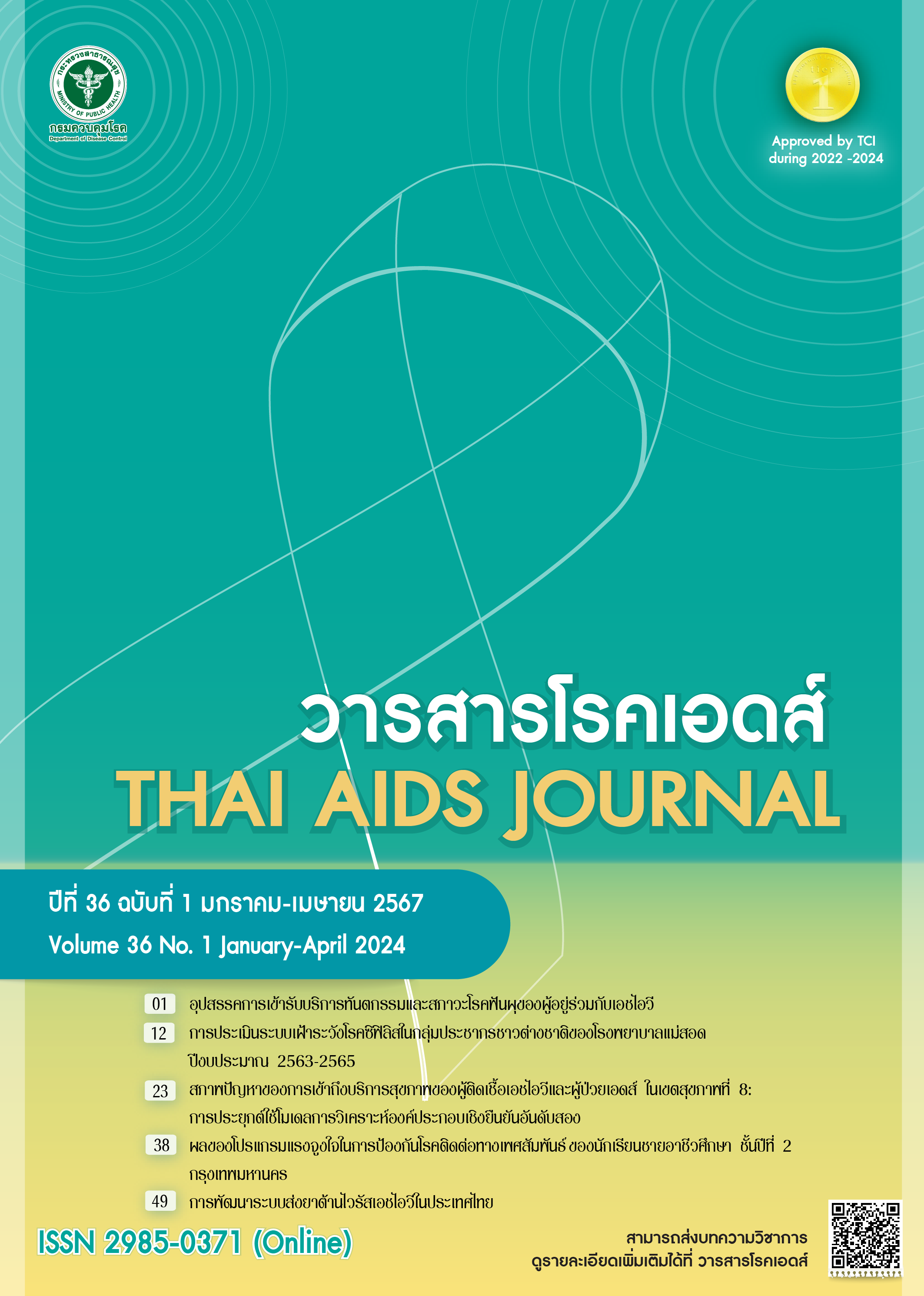อุปสรรคการเข้ารับบริการทันตกรรมและสภาวะโรคฟันผุของผู้อยู่ร่วมกับเอชไอวี
DOI:
https://doi.org/10.14456/taj.2024.1คำสำคัญ:
เอชไอวี, อุปสรรคในการรับบริการทันตกรรม, ดัชนีฟันผุ ถอน อุดบทคัดย่อ
การศึกษานี้เป็นการศึกษาแบบตัดขวางเพื่อศึกษาปัจจัยที่เป็นปัญหาหรืออุปสรรคในการเข้าถึงบริการทันตกรรม และศึกษาสภาวะฟันผุรวมถึงปัจจัยที่เกี่ยวข้องกับการเกิดฟันผุของผู้อยู่ร่วมกับเอชไอวีในโรงพยาบาลรัฐบาลแห่งหนึ่งในภาคใต้ เก็บข้อมูลโดยใช้แบบสอบถามชนิดตอบเอง และการตรวจช่องปากเพื่อตรวจประเมินค่าดัชนีฟันผุ ถอน อุด ผลการศึกษาพบกลุ่มตัวอย่างเป็นเพศหญิง 77 คน (ร้อยละ 51.0) อายุเฉลี่ย 44.0 ปี มีค่าดัชนีฟันผุ ถอน อุด 7.8 ซี่/คน โดยในรอบ 1 ปีที่ผ่านมามีผู้อยู่ร่วมกับเอชไอวีไม่ได้มารับบริการทันตกรรมถึงร้อยละ 67.5 โดยพบปัญหาหรืออุปสรรคในการเข้าถึงบริการทันตกรรม ได้แก่ ต้องนั่งรอคิวนานเป็นลำดับท้าย (ร้อยละ 45.7) ต้องนัดวันรับบริการใหม่ (ร้อยละ 17.8) กลัวการทำฟัน (ร้อยละ 17.2) และเคยถูกปฏิเสธให้การรักษาหรือถูกส่งต่อ (ร้อยละ 13.9) และจากการศึกษาถึงปัจจัยที่มีความแตกต่างของการเกิดฟันผุในกลุ่มผู้อยู่ร่วมกับเอชไอวี พบปัจจัยที่มีความแตกต่างอย่างมีนัยสำคัญทางสถิติ (p<0.05) ได้แก่ เพศหญิง อายุมากกว่า 35 ปี ค่าระดับเม็ดเลือดขาวชนิด CD4 ต่ำกว่า 500 cell/mm3 การแปรงฟันก่อนนอน การใช้น้ำยาบ้วนปาก และระดับความรู้ในการดูแลช่องปาก โรคฟันผุและการไม่ได้เข้ารับบริการทันตกรรมเป็นปัญหาสุขภาพช่องปากที่สำคัญของผู้อยู่ร่วมกับเอชไอวี โดยปัญหาที่เกิดจากการให้บริการที่สะท้อนมาควรได้รับการปรับปรุงเพื่อลดการถูกตีตราและเลือกปฏิบัติจากเจ้าหน้าที่ทันตกรรม และการให้ความรู้ในการดูแลช่องปากแก่ผู้อยู่ร่วมกับเอชไอวีเป็นสิ่งสำคัญและควรเกิดขึ้นในทุกหน่วยบริการ
Downloads
เอกสารอ้างอิง
Department of Disease Control. Estimated HIV infections Thailand [Internet]. Nonthaburi; 2022 [Cited 2023 Oct 9]. Available from: https://hivhub.ddc.moph.go.th/epidemic.php
Srithanaviboonchai K, Stockton M, Pudpong N, Chariyalertsak S, Prakongsai P, Chariyalertsak C, et al. Building the evidence base for stigma and discrimination-reduction programming in Thailand: development of tools to measure healthcare stigma and discrimination. BMC Public Health [Internet]. 2017 [updated 2017 March 11; cited 2023 Oct 17];17:245. Available from: https://doi.org/10.1186/s12889-017-4172-4
Department of Disease Control. HIV stigma and discrimination survey guidelines and procedures manual “health care provider”. Nonthaburi: National AIDS Management Center; 2015.
Krabi Provincial Health Office. HIV-related stigmatization and discrimination on people living with HIV and Thai health service providers. Krabi: Krabi Provincial Health Office; 2019. (in Thai)
Rungsiyanont S, Lam-Ubol A, Vacharotayangul P, Sappayatosok K. Thai dental practitioners' knowledge and attitudes regarding patients with HIV. J Dent Educ. 2013;77(9):1202-8.
Nazir M, Blinkhorn FA, Reilly D, Sedgewick K. The provision of dental treatment for HIV positive patients in Manchester. International Journal of Health Promotion and Education. 2005;43(1):11-6.
Rungsiyanont S, Vacharotayangul P, Lam-Ubol A, Ananworanich J, Phanuphak P, Phanuphak N. Perceived dental needs and attitudes toward dental treatments in HIV-infected Thais. AIDS Care. 2012;24(12):1584-90.
Nittayananta W, Talungchit S, Jaruratanasirikul S, Silpapojakul K, Chayakul P, Nilmanat A, et al. Effects of long-term use of HAART on oral health status of HIV-infected subjects. J Oral Pathol Med. 2010;39(5):397-406.
Tappuni AR. The global changing pattern of the oral manifestations of HIV. Oral Dis. 2020;26(1):22-7.
Ottria L, Lauritano D, Oberti L, Candotto V, Cura F, Tagliabue A, et al. Prevalence of HIV-related oral manifestations and their association with HAART and CD4+ T cell count: a review. J Biol Regul Homeost Agents. 2018;32(2 Suppl. 1):51-9.
Vohra P, Nimonkar S, Belkhode V, Potdar S, Bhanot R, Izna, et al. CD4 cells count as a prognostic marker in HIV patients with comparative analysis of various studies in Asia Pacific region. J Family Med Prim Care. 2020;31;9(5):2431-6.
Navazesh M, Mulligan R, Barron Y, Redford M, Greenspan D, Alves M, et al. A 4-year longitudinal evaluation of xerostomia and salivary gland hypofunction in the women's interagency HIV study participants. Oral Surg Oral Med Oral Pathol Oral Radiol Endod. 2003;95(6):693-8.
Bureau of Dental Health. The 8th national survey of dental health, Thailand (2017). Bangkok: Department of Health; 2018. (in Thai)
Broadbent JM, Thomson WM. For debate: problems with the DMF index pertinent to dental caries data analysis. Community Dent Oral Epidemiol. 2005;33(6):400-9.
Bloom BS. Taxonomy of education objective handbook. New York: David Mckay Company Inc; 1975.
Petersen PG, Baez RJ. Oral health survey: basic methods, 5th ed. Geneva: World Health Organization; 2013.
Parish C, Siegel K, Pereyra M, Liguori T, Metsch L. Barriers and facilitators to dental care among HIV-infected adults. Spec Care Dentist. 2015;35(6):294-302.
Giuliani M, Lajolo C, Rezza G, Arici C, Babudieri S, Grima P, et al. Dental care and HIV-infected individuals: are they equally treated? Community Dent Oral Epidemiol. 2005;33(6):447-53.
Aleixo RQ, Scherma AP, Guimaraes G, Cortelli JR, Cortelli SC. DMFT index and oral mucosal lesions associated with HIV infection: cross-sectional study in Porto Velho, Amazonian Region - Brazil. Braz J Infect Dis. 2010;14(5):449-56.
Saravani S, Nosrat ZT, Kadeh H, Mir S. Dental health status of HIV-positive patients and related variables in Southeast Iran. Int J High Risk Behav Addict [Internet]. 2016 [cited 2023 Oct 18];5(2):e29149. Available from: https://doi.org/10.5812/ijhrba.29149.
Shaghaghian S, Homayooni M, Amin M, Rezazadeh F. Oral health status of patients infected with human immunodeficiency virus and related factors, Iran: a cross-sectional study. BMC Oral Health [Internet]. 2021 [cited 2023 Oct 18];21(1):657. Available from: https://doi.org/10.1186/s12903-021-02002-3.
Phelan JA, Mulligan R, Ivelson E, Brunelle J, Alves ME, Navazesh M, et al. Dental caries in HIV-seropositive women. J Dent Res. 2004;83(11):869-73.
Nayak SK, Das BK, Das SN, Mohapatra N, Nayak S, Bhuyan L. Oral manifestations of human immunodeficiency virus/acquired immunodeficiency syndrome and their correlation to cluster of differentiation lymphocyte count in population of North-East India in highly active antiretroviral therapy era. Contemp Clin Dent. 2016;7(4):539-43.
Kalanzi D, Mayanja HK, Nakanjako D, Mwesigwa CL, Ssenyonga R, Amaechi BT. Prevalence and factors associated with dental caries in patients attending an HIV care clinic in Uganda: a cross sectional study. BMC Oral Health [Internet]. 2019 [cited 2023 Oct 18];19:159. Available from: https://doi.org/10.1186/s12903-019-0847-9.
Aminabadi NA, Balaei E, Pouralibaba F. The effect of 0.2% sodium fluoride mouthwash in prevention of dental caries according to the DMFT index. J Dent Res Dent Clin Dent Prospects. 2007;1(2):71-6.
Youssef L, Hallit S, Sacre H, Salameh P, Cherfan M, Akel M, et al. Knowledge, attitudes and practices towards people living with HIV/AIDS in Lebanon. PLoS One [Internet]. 2021 [cited 2023 Oct 18];16(3):e0249025. Available from: https://doi.org/doi: 10.1371/journal.pone.0249025.
Soufi LR, Davoodi P, Abdolsamadi HR, Jazaeri M, Malekzadeh H. Dental caries prevalence in human immunodeficiency virus infected patients receiving highly active anti-retroviral therapy in Kermanshah, Iran. Cell J. 2014;16(1):73-8.
Thanapaisal S. Oral health status and associated factors of HIV-infected patients with different duration of High Active-Antiretroviral Therapy (HAART) in Samutprakarn hospital. Region 11 Medical Journal. 2018;32(3):1155-64. (in Thai)
Murererehe J, Malele-Kolisa Y, Niragire F, Yengopal V. Prevalence of dental caries and associated risk factors among people living with HIV/AIDS and HIV uninfected adults at an HIV clinic in Kigali, Rwanda. PLoS One [Internet]. 2023 [cited 2024 Mar 13];18(4):e0276245. Available from: https://doi: 10.1371/journal.pone.0276245.



